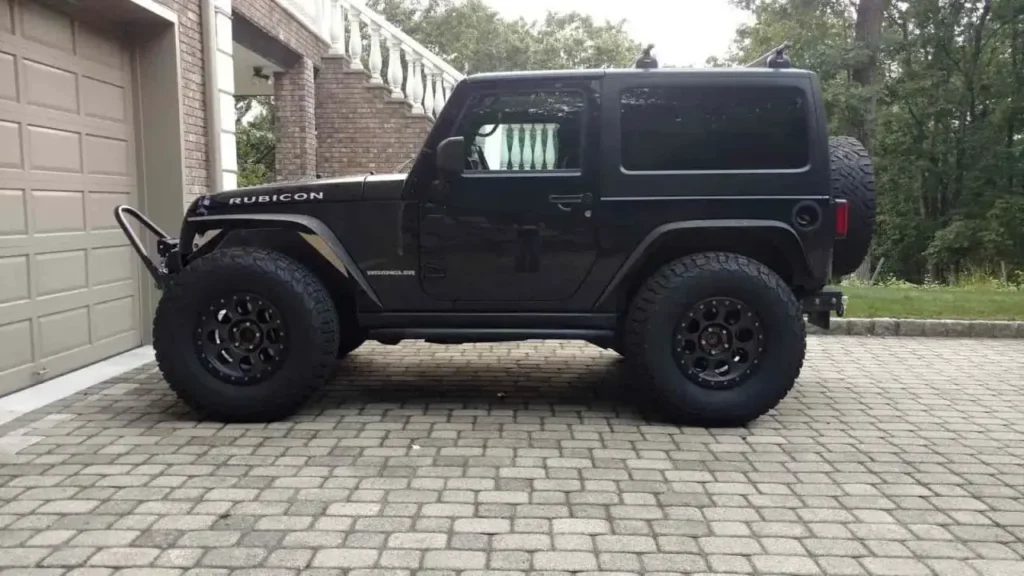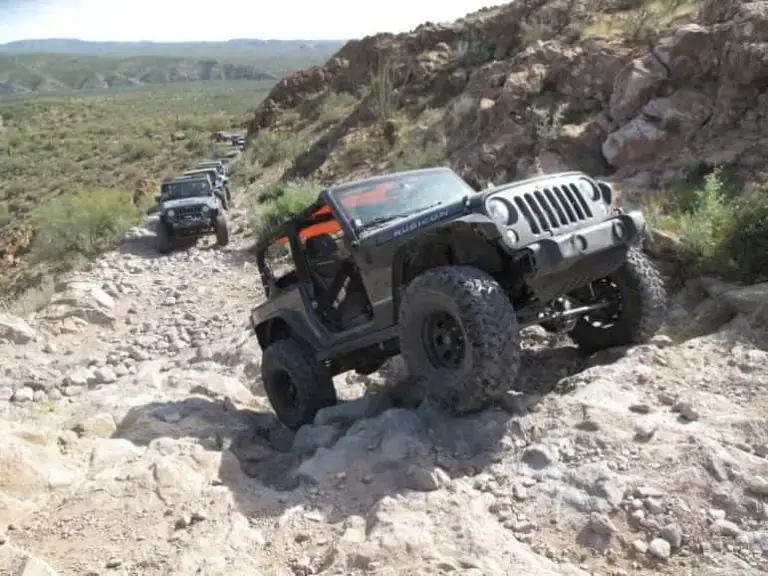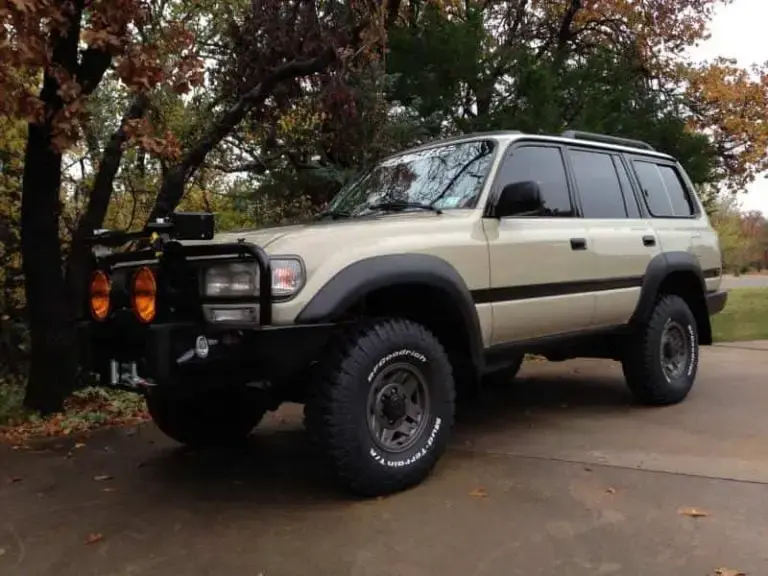When optimizing your vehicle’s capabilities, every detail matters – including tire size. Whether you’re a seasoned off-roader or simply seeking enhanced road grip, finding the perfect fit is crucial for maximizing your driving pleasure. Today, we journeyed through three popular tire sizes: 33 vs 35 vs 37 tires. Join us as we dissect each option’s advantages and disadvantages in search of the ultimate tire size that will revolutionize your ride.
33 vs. 35 vs. 37 Inch Tires: A Side-by-Side Comparison Table
The tire diameter is one of the important aspects, as it directly impacts your vehicle’s performance and overall handling. This comparison table will explore the positive and negative points of three popular tire sizes: 33, 35, and 37 inches.
| 33-inch tires | 35-inch tires | 37-inch tires | |
| Appearance | Appealing | More Appealing | Most Appealing |
| Height | High | Higher | Highest |
| Weight | Heavy | Heavier | Heaviest |
| Re gearing | Not necessary | More necessary | More necessary |
| Feel | Sluggish | More Sluggish | Most Sluggish |
| Ground Clearance | High | Higher | Higher |
| On-Road Rolling Resistance | Least | Less | More |
| Off-Road Rolling Resistance | More | Less | Least |
| Cost | High | Higher | Highest |
Overall Appearance of 33 vs 35 vs 37 Tires
While choosing the perfect tires, the appearance plays an important role. Let’s learn what the above three tires look like:
- Bigger tires, such as the 37-inch ones, are highly appealing due to their higher sidewalls and intricate tread designs. These tires provide an unmistakable off-road look that will turn heads wherever you go.
- 35-inch tires boast in-depth treads and are more visually appealing than their 33-inch counterparts.
- The 33-inch tires may be considered good-looking but must be higher than the larger options. Their aesthetic appeal cannot match that of the bigger tires with their captivating sidewall height and complex tread patterns.
Height & Weight
The 37-inch tire emerges as the tallest and heaviest option. Sitting in between are the 35-inch tires, offering a moderate balance in terms of weight and height. On the other end of the spectrum, we find the 33-inch tire, providing minimal ground clearance without being as heavy.
While choosing between these tire sizes, remember the impact on your vehicle’s speedometer accuracy. A smaller tire like the 33-inch can increase accuracy due to its shorter rolling circumference. This means that each revolution it completes corresponds more closely to a fixed distance travelled. Fitting larger tires like the 35 or 37-inch ones might offer enhanced off-road capabilities, providing greater ground clearance and traction on challenging terrains.
Re-gearing
When transitioning to larger tires, particularly those measuring 37 inches in diameter, re-gearing is crucial to prevent undue stress on the axle. Without re-gearing, the original gear ratio may no longer be compatible with the increased tire size, leading to performance issues and potential damage.
Not all tire sizes require re-gearing. For instance, when upgrading to 33-inch tires, re-gearing may not be necessary as the original gear ratio can still adequately handle this size. Regearing becomes imperative if opting for 35-inch tires or sticking with 37-inch ones.
Feel
37-inch tires tend to have the most pronounced effect when talking about feel. These massive tires can make your vehicle feel somewhat slow and unresponsive. Whereas upgrading to 35-inch tires does result in a slightly less sluggish feel compared to their 37-inch counterparts. Although the difference may not be drastic, these intermediate-sized tires balance increased height and maintain a relatively responsive driving experience.
Ground Clearance

A 33-inch all-terrain tire provides decent ground clearance for tackling rough terrains, it may struggle a bit when encountering particularly bumpy areas. But if you’re looking for even greater ground clearance, upgrading to a 35-inch tire would be wise. Compared to the 33-inch option, this larger tire offers more room underneath your vehicle, allowing you to better navigate over bumps and obstacles.
If ultimate ground clearance is what you desire, then stepping up to a hefty 37-inch tire is ideal. With this option, you’ll have even more coverage beneath your vehicle as it sits higher off the ground than the 33-inch and 35-inch tires. This increased clearance ensures smoother passage over any rugged terrain that comes your way.
Wanna know the causes, symptoms and prevention of round tires? in here.
On-road Performance
Here is how 33-inch, 35-inch, and 37-inch perform on road:
33-inch tires
Regarding on-road performance, 33-inch tires excel in various aspects due to their enhanced handling and traction on asphalt. They have smaller tire sidewalls, which are less flexible but provide better stability during fast and sharp turns. The smaller mass of 33-inch tires contributes to their exceptional on-road performance.
35-inch and 37-inch tires
The larger 35-inch and 37-inch tires fail to match the on-road prowess of their 33-inch counterparts. Their sidewalls’ increased size and flexibility can decrease stability and handling precision at higher speeds or when cornering aggressively. Consequently, these larger tires may compromise a vehicle’s overall performance when primarily used on paved roads.
Off-road Performance

Off-road, the 37-inch tire offers superior ground clearance compared to the smaller 35-inch tire because of its larger sidewall and overall tire profile. In addition to increased ground clearance, the 37-inch tire boasts better traction in muddy terrain. The larger size ensures a larger contact patch between the tire and the ground. This improved traction prevents slippage and helps maintain vehicle control even in challenging conditions.
The 35 and 37-inch tires have a larger circumference than their smaller counterparts, such as the 33-inch tire. A larger circumference enhances your vehicle’s ability to traverse obstacles by allowing for smoother rollover when climbing steep inclines or descending declines. It also provides a better grip on uneven terrain due to increased rotations per distance travelled.
On-road & Off-road Rolling Resistance
Tire rolling resistance is crucial in determining fuel efficiency, as it directly affects the effort required for a vehicle to move forward. Among different tire sizes, the 33-inch tire has been found to have the lowest on-road rolling resistance when compared to its counterparts.
If you venture off the beaten path, the 37-inch tire might be more suitable for you. This tire’s superior off-road rolling resistance increases traction and manoeuvrability on unpaved terrains. Consequently, it leads to better fuel economy when engaging in off-road driving. If your needs fall between daily commutes and adrenaline-fueled outdoor excursions, the 35-inch tire could be a balanced option.
Cost of 33 vs 35 vs 37 Tires

In particular, a 37-inch tire stands out as the priciest option on the market. Following closely behind in terms of cost is the 35-inch tire, which also falls within the higher price range due to its larger dimensions. One who is seeking a more budget-friendly option can approach the 33-inch tire. This size is considered less expensive than its larger counterparts due to its smaller dimensions.
Advantages of 33-Inch Tires
Here are some advantages of 33-inch tires
- 33-inch tires provide more clearance under the vehicle.
- These larger tires offer increased grip on various terrains, including mud, snow, and uneven surfaces.
- The wider footprint of 33-inch tires offers improved stability during cornering and manoeuvring on highways and off-road trails.
- Many people prefer the aesthetics of vehicles with larger tires as they tend to give a more aggressive and rugged look.
- With their larger size, 33-inch tires can help improve the towing capacity of vehicles equipped.
Disadvantages of 33-Inch Tires
- Larger tires often increase rolling resistance, which can negatively impact fuel efficiency by requiring more power to move the vehicle forward.
- Due to their increased weight compared to smaller tires, 33-inch tires may hinder acceleration performance.
- Upsizing to larger tires can lead to inaccurate vehicle dashboard gauge speed readings since they cover more ground per rotation.
- Purchasing and replacing 33-inch tires can be more expensive than smaller tires.
Advantages of 37-inch Tires
- The larger, more aggressive tread pattern provides better traction and handling on rough terrains.
- 37-inch tires raise the vehicle’s undercarriage, allowing it to clear obstacles like rocks or logs more easily.
- These tires offer a wider contact patch, improving stability while driving on and off-road.
- With taller sidewalls, 37-inch tires can absorb shocks and bumps more effectively, leading to a smoother ride.
- Larger tires give vehicles a more rugged and aggressive appearance.
Disadvantages of 37-Inch Tires
- Bigger tires create additional rolling resistance, leading to lower gas mileage.
- The added weight and stress from larger tires can accelerate wear on parts such as shocks and struts.
- Installing 37-inch tires may require modifications or upgrades to accommodate the bigger size properly.
- Compared to smaller sizes, 37-inch tires are more expensive upfront and incur higher maintenance costs.
Wrapping Up “33 vs 35 vs 37 Tires”
Understanding the distinctions between these tire sizes lets you decide which option will best fulfil your needs. Whether you prioritize versatility, enhanced performance on rough terrain, or dominating extreme off-road conditions, there is no bad choice here. This knowledge makes selecting the perfect tires for your vehicle much simpler.
FAQs
What Is The Best Rim Size For 33 Inch Tires?
The best rim size for 33-inch tires is generally between 15 and 16 inches in width. This ensures a proper fit and optimal performance for your tires.
What Is The Best Rim Size For 35-Inch Tires?
When choosing rims for 35-inch tires, using at least a 17-inch width is recommended.
What Is The Best Rim Size For 37 Inch Tires?
A 37-inch tire should have an 18-inch wide rim to avoid potential issues. A 17-inch rim may still be used but could cause problems due to the tire’s width.
What size is comparable to a 33 tire?
Typically, 33-inch tires are comparable in size to 285/75R16 in metric units, but 285 tires have a slightly smaller diameter at 32.8 inches instead of 33 inches. The metric size of 285/75R16 is generally considered acceptable for a 33-inch tire.

